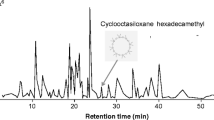Abstract
Forty-five samples from 1988–1995 of naturally contaminated grain, barley, wheat and oats, three samples of mixed feed, and 16 samples of grain artificially inoculated with Fusarium culmorum during the flowering stage were analysed for deoxynivalenol (DON), 3-acetyldeoxynivalenol (3-acetyl-DON), culmorin and hydroxy-culmorins. These compounds are secondary metabolites produced by the fungal species F. culmorum and F. graminearum. Acetonitrile-water extract of the samples was purified on a MycosepTM#225 column, derivetized using pentafluoropropionic anhydride (PFPA) and analysed by gas chromatography-mass spectrometry (GC-MS). The amount of each of culmorin, 5-, 12-, 14 and 15-hydroxy-culmorin and one unknown hydroxy-culmorin were determined relative to the amount of DON plus 3-acetyl DON for each sample. The ratio between the total amount of culmorin compounds and the DON compounds ranged from 0.14 to 1.07 in the samples. This study shows that there is a strong correlation between the amount of DON present in the grain and the amount of culmorin and hydroxy-culmorins present. The ratio of each of the culmorin compounds relative to the amount of DON compounds were in the same range in the grain artificially inoculated by F. culmorum as found in an earlier study for F. culmorum strains cultivated on rice, while the hydroxy-culmorin profile in the naturally contaminated grain was more similar to what was found for the F. graminearum cultures in the same study [1]. These results indicate that F. graminearum may be a relatively important source for DON in grain also in relatively cold areas.
Similar content being viewed by others
References
Langseth W, Ohebremeskel M, Kosiak B, Kolsaker P, Miller D. Production of culmorin compounds and other secondary metabolites by Fusarium culmorum and F. graminearum strains isolated from Norwegian cereals. Mycopathologia 2001, accepted.
Hanson JR, Nyfeler R. Studies in terpenoid biosynthesis. Part 18. Biosynthesis of culmorin. J Chem Soc Perkin Trans 1976; 23: 2471-2475.
Ashley JN, Hobbs BC, Raistrick H. LV. Studies in the biochemistry of micro-organisms LIII. The crystalline colouring matters of Fusarium culmorum (W.G. Smith) Sacc. and related forms. Biochem J 1937; 31: 385-397.
Barton DHR, Werstiuk NH. The constitution and stereochemistry of culmorin. Chem Commun 1967; 1: 30-31.
Barton DHR, Werstiuk NH. Sesquiterpenoids. Part XIV. The constitution and stereochemistry of culmorin. J Chem Soc (C) 1968; 148-155.
Kasitu OC, ApSimon JW, Blackwell BA, Fielder DA, Greenhalgh R, Miller JD. Isolation and characterization of culmorin derivatives produced by Fusarium culmorum CMI 14764. Can J Chem 1992; 70:1308-1316.
Greenhalgh R, Levandier D, Wyman A, Miller JD, Blackwell BA, McAlees AJ, Taylor A. Production and characterization of deoxynivalenol and other secondary metabolites of Fusarium culmorum (CMI 14764, HLX 1503). J Agric Food Chem 1986; 34: 98-102.
Miller JD, Greenhalgh R, Wang YZ, Lu M. Trichothecene chemotypes of three Fusarium species. Mycologia 1991; 83: 121-130.
Langseth W, Bernhoft A, Rundberget T, Kosiak B, Gareis M. Mycotoxin production and cytototxicity of Fusarium strains isolated from Norwegian cereals. Mycopathologia 1999; 144: 103-113.
Snijders CHA, Perkowski J. Effects of head blight caused by Fusarium culmorum on toxin production and weight of wheat kernels. Phytopathology 1990; 80: 566-570.
Miller JD. Epidemiology of Fusarium ear diseases of cereals. In: Miller JD, Trenhoim HL, eds. Mycotoxins in grain: Compounds other than aflatoxin. St. Paul: Eagon Press, 1994; 19-36.
Ichinoe M, Kurata H, Sugiura Y, Ueno Y. Chemotaxonomy of Gibberella zeae with special reference to production of trichothecenes and zearalenone. Appl Environ Microbio 1983; 46: 1364-1369.
Pettersson H. Trichothecene occurrence in European cereals-a review. Martina Franca, Italy: International Seminar on Fusarium, 1995.
Langseth W and Elen O. The occurrence of deoxynivalenol in Norwegian cereals differences between years and districts, 1988-1996. Acta Agric Scand, Sect B, Soil and Plant Sci 1997; 47: 176-184.
Scott PM. Multi-year monitoring of Canadian grains and grain-based foods for trihothecenes and zearalenone. Food Add Contam 1997; 14: 333-339.
Beasley VR. ed. Trichothecene mycotoxicosis: Pathophysiologic effects. Florida: CRC Press, 1989.
Smith JE, Henderson RS. eds. Mycotox ins and animal foods, London: CRC Press, 1991, 119.
Smith JE, Solomons GL. eds. Mycotoxins in human nutrition and health. EC DirectorateGeneral XII Science research and development EUR 16048 EN, 1994.
Rotter BA, Prelusky DB, Pestka JJ. Toxicology of deoxynivalenol (Vomitoxin). J Toxicol Environ Health 1996; 48: 1-34.
Foster BC, Trenholm HL, Friend DW, Thompson BK, Hartin KE. Evaluation of different sources of deoxynivalenol (vomitoxin) fed to swine. Can J Anim Sci 1986; 66: 1149-1154.
Trenhoim HL, Foster BC, Charrnley LL, Thompson BK, Hartin KE, Coppock RW, Albassam MA. Effects of feeding diets containing Fusarium (naturally) contaminated wheat or pure deoxynivalenol (DON) in growing pigs. Can J Anim Sci 1994; 74: 361-369.
Dowd PF, Miller JD, Greenhalgh R. Toxicity and interactions of some Fusarium graminearum metabolites to caterpillars. Mycologia 1989; 81: 646-650.
Pedersen PB, Miller JD. The fungal metabolite culmorin and related compounds. Natural Toxins 1999; 7: 305-309.
Foster BC, Neish GA, Lauren DR, Trenholm HL, Prelusky DB, Hamilton RMG. Fungal and mycotoxin content of slashed corn. Microbiologie-Aliments-Nutrition 1986; 4: 199-203.
Liu W, Langseth W, Skinnes H, Elen ON, Sundheim L. Comparison of visual head blight ratings, seed infection levels, and deoxynivalenol production for assessment of resistance in cereals inoculated with Fusarium culmorum. European J Plant Pathology 1997; 103: 589-595.
Langseth W, Rundberget T. The occurrence of HT-2 toxin and other trichothecenes in Norwegian cereals. Mycopathologia 1999; 147: 157-165.
Langseth W, Ghebremeskel M, Røise H, Kolsaker P. Mass spectra of trichothecenes and other Fusarium metabolites alter derivatization with a pentafluoroproionyl reagent. Manuscript 2001.
Kosiak B, Torp M, Thrane U. The occurrence of Fusarium spp. in Norwegian grain-A survey. Cereal Res Commun 1997; 25: 595-596.
Author information
Authors and Affiliations
Rights and permissions
About this article
Cite this article
Ghebremeskel, M., Langseth, W. The occurrence of culmorin and hydroxy-culmorins in cereals. Mycopathologia 152, 103–108 (2001). https://doi.org/10.1023/A:1012479823193
Issue Date:
DOI: https://doi.org/10.1023/A:1012479823193




